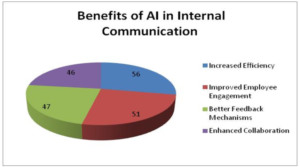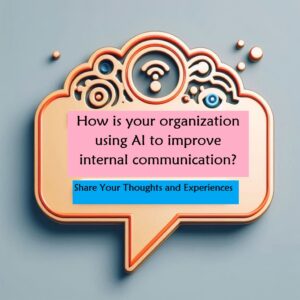How AI is Revolutionizing Internal Communication Strategies
Introduction
The modern workplace is in the midst of a technological transformation, with Artificial Intelligence (AI) reshaping how organizations communicate internally. As businesses become more global and dispersed, the need for streamlined, efficient, and personalized communication tools is growing. AI is stepping in to fill this gap by automating tasks, enhancing collaboration, and providing real-time insights that were previously unattainable. From virtual assistants to advanced sentiment analysis, AI is helping organizations maintain fluid and effective communication.
Internal communication has traditionally been a significant challenge for businesses, especially in large, multinational organizations where teams are scattered across time zones. Miscommunications, delays in message delivery, and lack of engagement often lead to inefficiencies and missed opportunities. AI changes the game by automating routine tasks, enabling personalized communication, and providing real-time feedback that allows companies to stay agile in an ever-changing environment. With tools that can predict needs, streamline workflows, and break language barriers, AI is setting a new standard for how teams interact within organizations.
This article explores the transformative role of AI in internal communication, illustrating how AI-powered tools, personalized experiences, and automation are enabling organizations to improve efficiency, increase employee satisfaction, and foster a culture of open, seamless communication.
AI-Powered Communication Tools: The New Normal
One of the most significant ways AI is revolutionizing internal communication is through AI-powered tools like chatbots, virtual assistants, and AI-driven collaboration platforms such as Microsoft Teams and Slack. These AI-enabled tools simplify communication by automating tasks such as answering frequently asked questions, scheduling meetings, or disseminating important company-wide announcements. With these routine tasks being handled efficiently, employees can concentrate on more strategic work, thus increasing productivity.
For example, virtual assistants can automatically schedule meetings based on the availability of team members or issue timely reminders about project deadlines. By doing so, AI not only saves time but ensures that communication is streamlined and organized. Additionally, AI’s ability to process language means that messages are delivered accurately, reducing the potential for misunderstandings or missed communications within teams.
Flowchart: AI-Driven Communication Process

Multicolor Professional Chronological Timeline Infographic – 2
Personalizing the Employee Experience with AI
A major strength of AI is its ability to analyze vast amounts of data, allowing it to personalize internal communication. By analyzing employee communication patterns, preferences, and work habits, AI can deliver targeted and personalized messages to individuals. This might include recommending learning resources relevant to recent project activities or providing updates tailored to specific interests.
For instance, AI can assess an employee’s workload and send reminders about wellness programs, career development opportunities, or suggest new tools that could improve productivity. Personalized communication helps employees feel more connected to the organization, making them more engaged and satisfied in their roles. This level of personalization fosters a sense of care and attention that is often missing in traditional, one-size-fits-all internal communication strategies.
Pie Chart: Benefits of AI in Internal Communication

AI in Multilingual Communication
As businesses expand across borders, one of the key challenges in internal communication is multilingual collaboration. AI is stepping up by providing real-time translation tools that make it easier for teams spread across different regions to communicate effectively. Whether it’s translating emails, internal messages, or company documents, AI ensures that language barriers don’t prevent collaboration or understanding within a global workforce.
By leveraging AI-powered translation tools, organizations can foster inclusivity and allow team members from diverse backgrounds to contribute equally. This also ensures that employees from various regions can access critical information in their native language, making collaboration smoother and more effective. For multinational teams, this leads to greater cohesion and productivity, ultimately driving business success.
AI Enhancing Feedback and Employee Insights
AI tools such as sentiment analysis are transforming how companies gather and interpret employee feedback. Through AI, organizations can gain insights into employee morale by analyzing internal communication, emails, or feedback surveys. Sentiment analysis tools can identify patterns and trends in how employees feel, giving management a clearer picture of engagement and satisfaction levels.
For example, if employees are frequently using negative language around certain topics, AI can flag this to managers who can then address issues proactively. This real-time feedback mechanism helps organizations respond to concerns before they escalate, promoting a healthier and more transparent work environment. AI also allows for quicker, more detailed responses to employee feedback, reinforcing a culture of continuous improvement and openness.
Bar Chart: Adoption Rates of AI Tools in Organizations


Automating Routine Communication Tasks
AI’s ability to automate routine tasks in communication processes is another significant benefit. Tasks such as sending notifications, meeting reminders, and project updates can be automated by AI, ensuring that important messages are delivered promptly without manual effort. For example, AI can monitor project timelines and automatically notify team members when deadlines are approaching or when key milestones have been achieved.
Automating these tasks reduces the burden on human workers, allowing them to focus on more critical responsibilities. This level of automation helps keep teams organized and up-to-date, ensuring that communication remains timely and efficient. Additionally, by automating routine updates and reminders, organizations can reduce errors and delays, leading to improved performance and better outcomes.
Timeline Infographic: The Evolution of AI in Internal Communication

Multicolor Professional Chronological Timeline Infographic – 1
How AI is Reshaping the Future of Internal Communication
Looking ahead, the future of internal communication is set to be dominated by AI-driven innovations. Technologies such as virtual reality (VR) and augmented reality (AR) are expected to play a major role in how teams communicate and collaborate in the coming years. AI-powered virtual meetings in fully immersive 3D environments could soon become a reality, allowing teams to interact and solve problems in ways that traditional communication tools cannot match.
As AI continues to evolve, it will enable even more advanced tools for real-time collaboration and communication. AI will further enhance how messages are personalized, ensuring that communication is always relevant, timely, and effective. The companies that embrace these new technologies will position themselves at the forefront of the communication revolution, gaining a competitive edge in their industries.
Conclusion
AI is fundamentally transforming how organizations communicate internally. From automating repetitive tasks to personalizing messages and improving multilingual collaboration, AI is creating more efficient, engaged, and productive workforces. Organizations that invest in AI-driven communication tools will not only improve internal workflows but also foster a culture of transparency, collaboration, and innovation.


